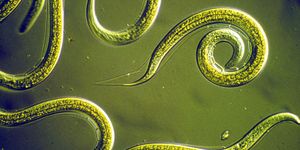Space & Astronomy
Ireland From Space On St Patrick's Day
MAR 23, 2015 6:10 PM PDT
Share
Welcome back old friend
 Scientists at Harvard University are one step closer to bringing Woolly mammoths back to life, after successfully inserting some sequences of mammoth DNA into an elephant genome. The study is yet to be published, though, as there is still work to do.
Scientists at Harvard University are one step closer to bringing Woolly mammoths back to life, after successfully inserting some sequences of mammoth DNA into an elephant genome. The study is yet to be published, though, as there is still work to do.No recreation of the Ice Age would be complete without large, shaggy woolly mammoths stomping across the frozen tundra. That is what George Church, a professor of genetics at Harvard University and his team ultimately hope to achieve once more.
Taking a preserved Arctic permafrost specimen of a Woolly mammoth, scientists analyzed mammoth DNA before reproducing exact copies of fourteen mammoth genes.
"We prioritized genes associated with cold resistance including hairiness, ear size, subcutaneous fat and, especially, hemoglobin," Church told The Sunday Times.
The woolly mammoth was one of the last in the line of the species that emerged in the early Pliocene age some 2.5 million years ago but almost completely died 10,000 years ago. Some mammoths, however, continued to survive on Wrangel Island in the Arctic Ocean, between the Chukchi Sea and East Siberian Sea, until around 3,300 years ago. These were the specimens which researchers used for the DNA analysis.
The scientists inserted mammoth genes into the cells of its closest living relative, the Asian elephant.
The introduction of the genes was done through a new developed technique CRISPR (clustered regularly interspaced short palindromic repeat), that allows for precise editing of DNA taking out parts of modern elephant DNA and replacing them the prehistoric genes.
"We now have functioning elephant cells with mammoth DNA in them," Church announced.
"We have not published it in a scientific journal because there is more work to do, but we plan to do so," he added.
Beth Shapiro, University of California professor, in her new book, ‘How to Clone a Mammoth: The Science of De-Extinction' explores the possibility of mammoth resurrection, as a number of well-preserved species have been found in the past.
"If we really want to bring mammoths back to life, then we're in luck, as far as DNA preservation goes. It's in pretty shoddy condition, so hard to piece together, but if we sort through these tiny pieces, finding where they fit along the elephant genome, then we can slowly build a lot of the mammoth genome."
Professor Church believes that bringing the ancient mammoth back eventually could have a positive impact on the ecosystems in Russia. "The Siberian permafrost is melting with climate change, but research suggests large mammals could stabilize it," he said.
Source: http://rt.com/news/243097-dna-mammoth-cloning-progress/
You May Also Like
Loading Comments...








